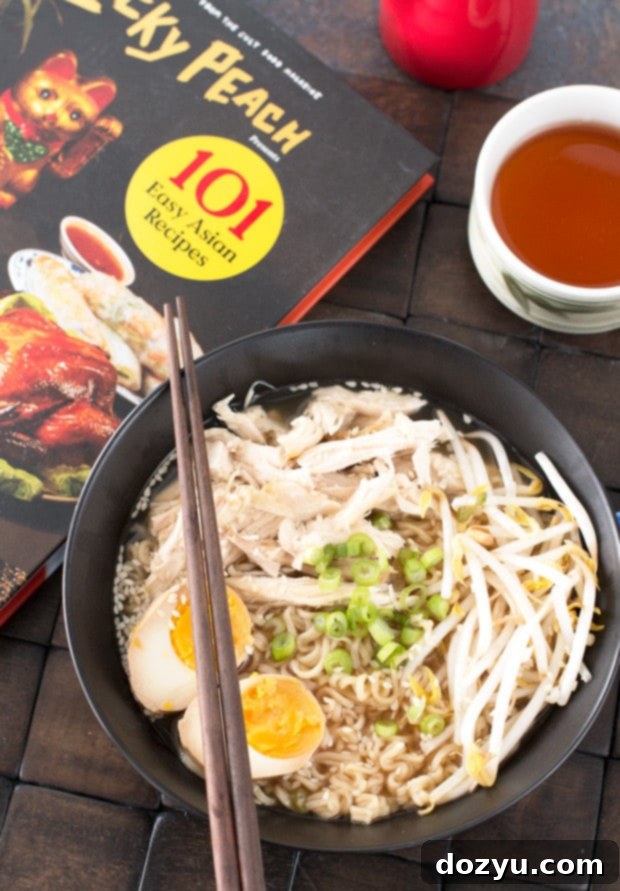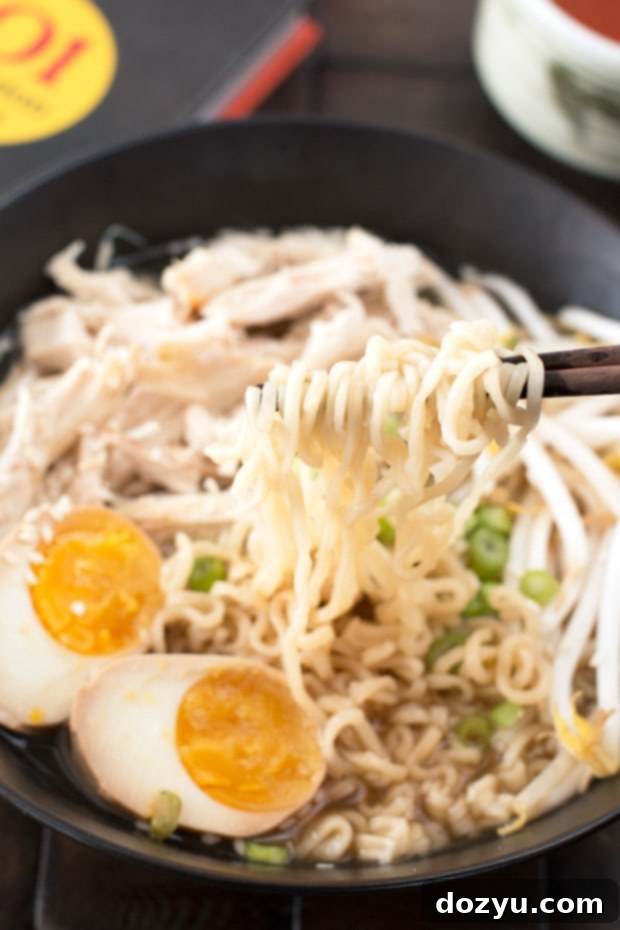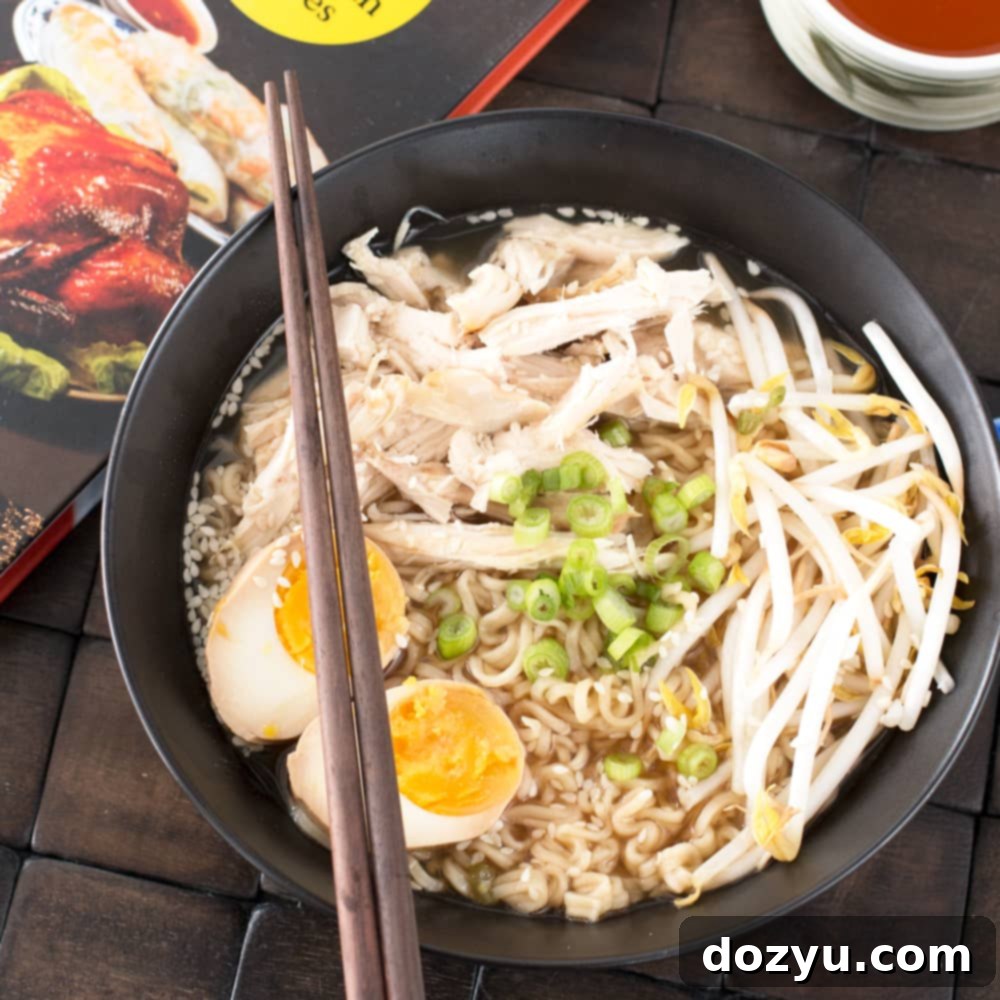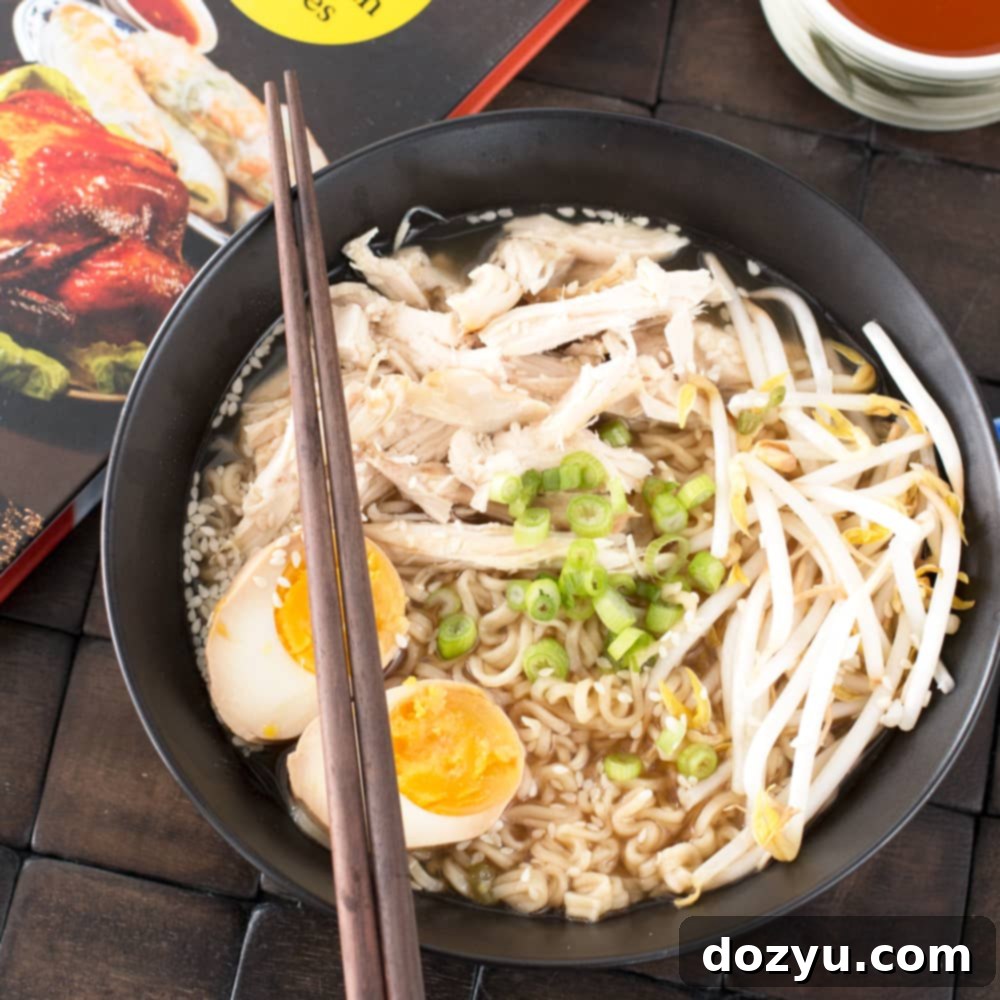The Ultimate Easy Rotisserie Chicken Ramen: A Flavorful Weeknight Comfort Inspired by Lucky Peach
Transforming a simple store-bought rotisserie chicken into a deeply satisfying bowl of ramen has become my new culinary obsession. This incredible Rotisserie Chicken Ramen recipe, straight from the pages of the “Lucky Peach: 101 Easy Asian Recipes” cookbook, is an absolute game-changer for weeknight comfort. While the rich, aromatic broth does require a couple of hours to simmer to perfection, the minimal active effort and the unparalleled depth of flavor you achieve make every minute of waiting utterly worthwhile. Prepare to be amazed by this unbelievably good, flavor-packed bowl of goodness.

This year, my kitchen adventures have taken a delightful turn towards exploring more Asian recipes. As someone who readily admits to being a complete novice in this culinary realm, receiving the *Lucky Peach: 101 Easy Asian Recipes* cookbook in the mail felt like a revelation. For this cookbook-obsessed gal, it was truly the gift that keeps on giving! The inspiration to finally dive into homemade ramen struck after a lunch with a friend who raved incessantly about the mouth-watering chicken ramen she and her partner prepare. Their vivid descriptions ignited a serious craving within me. So, as I eagerly skimmed through the glossy pages of *Lucky Peach*, contemplating which delicious creation to tackle first, there it was – Rotisserie Chicken Ramen. It felt like destiny, a recipe specifically crafted for someone exactly like me, promising both ease and authentic flavor.
The concept of using a humble rotisserie chicken, a staple of grocery store convenience, to create such an elevated dish immediately captivated me. It demystifies the often-intimidating process of making ramen from scratch, making it accessible to even the most inexperienced home cook. This recipe truly bridges the gap between store-bought convenience and gourmet quality, transforming a simple ingredient into something extraordinary. It’s an ingenious approach that saves time and still delivers on taste, perfectly aligning with the “easy Asian recipes” promise of the book.

Crafting the Perfect Ramen Broth: A Labor of Love (That Doesn’t Feel Like Labor)
The heart and soul of any great ramen lies undoubtedly in its broth, and this recipe delivers a seriously unreal flavor profile. While it does take a bit of time, let’s be clear: “time” in this context mostly means passive simmering on the stove while you go about your day. There’s no constant stirring or complex techniques involved. You simply combine the ingredients, bring it to a boil, and then let it gently bubble away, filling your home with the most intoxicating aromas. This hands-off approach makes it a perfect weekend project or a relaxed weekday evening cook, allowing you to multitask or simply unwind while your broth develops its magical depth.
I had the pleasure of sharing this divine broth with my mom on a snowy day here in Denver, and it was absolutely exquisite. We both savored every single spoonful, slurping in happy silence until our bowls were completely empty. If that shared experience of pure, unadulterated culinary contentment doesn’t speak volumes about how incredibly good this recipe is, I honestly don’t know what will. The warmth, the rich chicken flavor, the subtle notes of ginger and shiitake – it all combines into a truly comforting and memorable experience, perfect for chasing away the winter chill or simply indulging in a moment of delicious tranquility. The flavor extraction and reduction over those two hours create a broth that is complex, savory, and incredibly satisfying, far surpassing any instant ramen packet you might encounter.

A Crucial Step: The Art of Skimming for a Cleaner Broth
One of the seemingly small but profoundly impactful steps highlighted in the *Lucky Peach* recipe is skimming the broth during the initial 10 minutes of simmering. You might wonder, “Do I really need to do this?” And the answer is a resounding yes. Skimming isn’t just about aesthetics; it’s about achieving a superior flavor. With rotisserie chicken, there’s often rendered grease that, if left unskimmed, can emulsify and result in a muddy, dull-tasting broth. Our early unskimmed attempts at this recipe yielded murky, somewhat flat results. This careful removal of froth and excess fat during those crucial first minutes forces you to engage with your broth, observe its consistency, and ensures a cleaner, clearer, and ultimately more vibrant-tasting soup base. This dedication to detail is what transforms a good broth into an exceptional one, leading to a much better bowl of ramen overall.
Don’t Forget the Soy Sauce Eggs!
Oh, and if you get the book – and I strongly recommend you do – you absolutely, unequivocally *must* make the soy sauce eggs. Seriously, they are a revelation! These perfectly cooked, deeply flavored eggs are not just a garnish; they are an essential component that elevates the entire ramen experience. Their rich, umami-packed flavor and luscious, slightly jammy yolk are an incredible complement to the savory broth and tender chicken. “AH, such good. Very wow” barely begins to describe the delightful explosion of flavor they add to each bite. Do yourself a favor and prioritize making these; they are a true game-changer for homemade ramen.
The *Lucky Peach* cookbook itself is a gem. It’s a sassy, sometimes snarky, yet always insightful ode to Asian cooking that genuinely caters to someone who might not feel 100% confident tackling Asian recipes (in other words, ME!). Its language is straightforward, making it an incredibly fun and engaging read. What truly sets it apart, however, are the photos. Unlike many other cookbooks gracing my shelves that feature impossibly gorgeous, aspirational food photography, *Lucky Peach* presents recipes that actually look achievable. You know those cookbooks where the dishes look so perfect you instinctively know you’ll never replicate them because you’re not a superhuman chef (or, like me, you’re just a tad clumsy)? This book is the opposite. You can genuinely cook these recipes, and they will turn out looking remarkably similar to the photos. There’s a subtle stroke of genius in that approach, making delicious Asian cuisine feel truly within reach for everyone.

For all my fellow home cooks out there who feel a bit tentative about diving headfirst into the wonderful world of Asian cuisine, this book is your ultimate lifeline. It dismantles the intimidation factor, offering a guiding hand through approachable recipes and helpful insights. After experiencing the sheer delight of this Rotisserie Chicken Ramen, I’m already eyeing the slow cooker pho recipe next. I promise to report back on that culinary adventure soon! In the meantime, equip yourself with a copy of *Lucky Peach* and prepare to impress yourself with the incredible flavors you can create.
Disclosure: I received this book from theBlogging for Books program in exchange for this review. As always, all opinions are my own.

Rotisserie Chicken Ramen
ingredients
- 1 rotisserie chicken whole or leftover
- 4 scallions
- 1 piece 1″ fresh ginger, thinly sliced
- 1 small carrot optional
- 1 dried shiitake mushroom
- 3 slices bacon about 2 oz
- 12 C water
- 4 portions ramen noodles preferably fresh
- 8 t soy sauce
- 2 cooked eggs optional but very nice; see Soy Sauce Eggs, page 50 – get the book and make these!, halved
instructions
-
If you’re starting with a leftover rotisserie chicken carcass, scavenge it for good meaty bits, and set them aside. If you have purchased a cooked chicken expressly for this recipe, then carefully cut away the breast meat, reserve the drumsticks, and use your fingers to shred off the leg meat—but just the big, fit-for-a-king pieces that come away easily. You can leave plenty of chicken on the carcass; that clingy meat will make for a flavorful soup. Pull or slice the meat into bite-size pieces and reserve in the fridge while you make the broth
-
Break the chicken carcass into a few pieces and put them in a stockpot. Trim the roots and dark green parts of the scallions and add them to the pot; thinly slice the white and tender green parts and reserve them to garnish the soup. Add the ginger, carrot (if using), shiitake, and bacon. Add the water and bring to a boil. Reduce the heat from a rolling boil to a rollicking simmer, and skim any froth that collects on the surface during the first 10 minutes of simmering.
-
Cook until the liquid is reduced by one-third (to 8 cups), about 2 hours. Strain the broth. (That shiitake is probably pretty delicious and tender at this point so you can save and slice it and use it as a garnish on the finished dish, but scrap the rest.) The broth can be used immediately or refrigerated for up to 2 days.
-
To serve: Bring the broth to a strong simmer and cook the ramen noodles according to package directions. Drain the noodles very well, and portion them out among 4 deep soup bowls. Top with broth. Season each bowl with 2 teaspoons soy sauce, a portion of the reserved chicken meat, scallions, half an egg, and whatever else you’ve got. (See ideas on the following pages!) Eat immediately.
notes
We don’t want to make you do anything you’re not comfortable with. But we found that 2 hours is the sweet spot for flavor extraction and reduction. Also, you don’t really do anything during that time except for maybe cook an egg or two—plenty of time to watch an old Eddie Murphy movie or stare endlessly into the antisocial abyss that is your smartphone!
BUT BUT BUT Why do I have to skim it?
Skimming the broth during the first 10 minutes will force you to pay attention to the hardness of the simmer, observe the water level in the pot, and get to know the broth. Also, we found that with rotisserie chicken (unlike plain old raw chicken), there is some rendered grease that can emulsify in a muddy way. Our early stabs at this broth went unskimmed; they came out murky and tasted sort of flat. This approach yields a cleaner-tasting and clearer soup—and a better bowl of ramen.
Pin this Rotisserie Chicken Ramen recipe for later!

